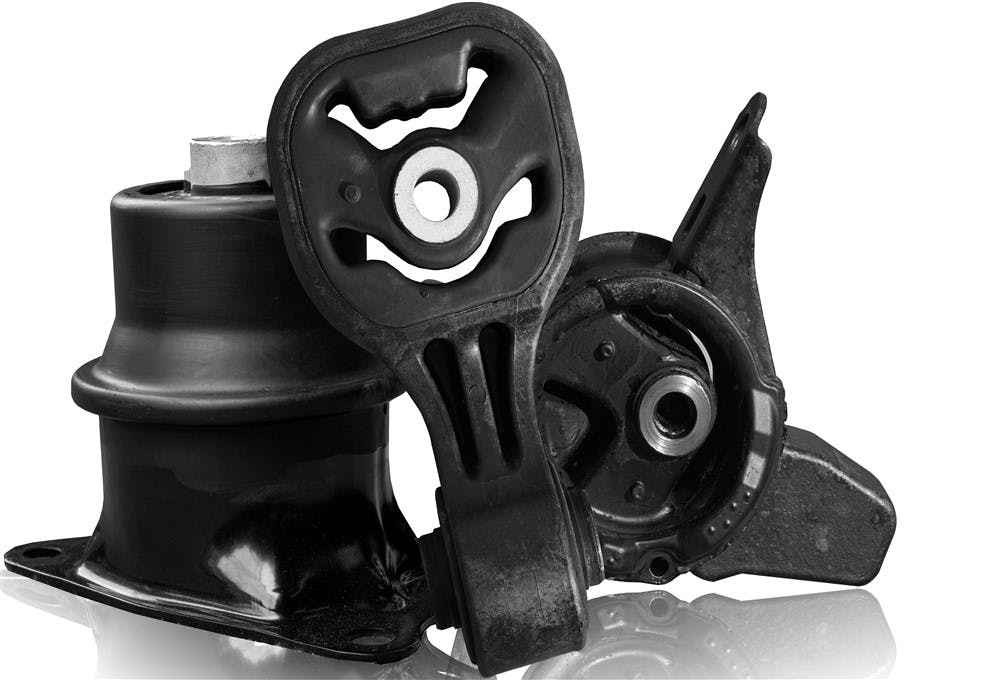Are there Different Types of Engine Mounts?

Although engine mounts come in a huge range of shapes, sizes, and configurations, all engine mounts fall into one of three broad categories, based on both their construction and the material(s) used as damping mechanisms. Be aware though that any given vehicle might be equipped with one or more categories of engine mounts, with each mount being designed for that specific application on that vehicle. Below are some details of the specifics of each category of engine mount that is commercially available today-
Solid engine mounts
Although most solid engine mounts consist of solid cylindrically shaped rubber cushions or composites of different rubber-containing compounds that are contained within steel brackets, some absorbing cushions may consist of solid polyurethane, neoprene, or purpose-designed compounds that sometimes contain both rubber and neoprene compounds.
One sub-category of solid mounts includes mounts whose absorbing cushions are "split" in one or more directions to improve or increase the mount's flexibility and/or elastic rate in one particular direction. Note, though, that while split rubber mounts offer excellent vibration and noise suppression at low cost, their single biggest drawback is that the excessive engine movements they are designed to control often produce stress fractures in the soft rubber compounds they are made of long before similar fractures occur in solid rubber mounts.
Hydraulic engine mounts
Instead of using solid but flexible absorbing cushions, hydraulic engine mounts use hydraulic oil or viscous gels of various types that are contained in cavities in somewhat solid structures to absorb engine vibrations in much the same way that shock absorbers damp out suspension movements. In theory, the oil or gel in the cavities are intended to absorb engine vibrations in three axes before they can reach the vehicle’s structure, but the practice is often somewhat different.
Much of how well (or otherwise) hydraulic engine mounts work has to do with whether it is an OEM part or an aftermarket part. This is, however, not the same as saying that all aftermarket hydraulic engine mounts are bad, far from it, because many manufacturers of high-quality engine mounts supply both the aftermarket and OEMs with the same parts and products.
However, it should be noted that for a hydraulic engine mount to work as intended, it has to be calibrated or “tuned” to the specific vibrational frequencies that occur on the applications it was designed for. Thus, since hydraulic engine mounts are much more expensive to produce than simple, solid rubber mounts, the aftermarket is flooded with cheap, substandard knock-offs of OEM mounts that might look like an OEM part, but that is where the resemblance often ends.
With cheap aftermarket hydraulic engine mounts there is usually a mismatch between the frequencies the mount can absorb and the frequencies it must absorb, leading to engine vibrations passing almost directly into the passenger cabin. Moreover, cheap hydraulic engine mounts are also prone to early failure, which when it happens, places extreme demands on the other engine mounts, which could cause the premature failure of one or more engine mounts that may have been in a good condition before the hydraulic mount failed.
Active engine mounts
Active engine mounts are highly complex components that use specialised sensors to measure changes in the frequency of engine vibrations that occur because of changes in the engine’s speed and load. We need not delve into the complexities of how the various types of active engine mounts react to changes in vibrational frequencies here, beyond saying that in all cases, a microprocessor increases or decreases the mount’s damping characteristics to suit the current conditions.
For example, in some designs, the positive pressure in an active mount could be decreased to damp out severe, low-frequency vibrations, or, the positive pressure could be increased to absorb high-frequency vibrations that have small amplitudes.
In more advanced designs, a microprocessor could activate solenoids and valves in the mount to produce movements that mimic the incoming vibrational frequencies, but in an opposite direction. This strategy is known as “destructive interference” since the two opposing vibrational frequencies cancel each other out.
Note that since these types of mounting are very expensive because they actively prevent vibrations from passing into the vehicle’s structure, they are usually only used on high-end luxury vehicles whose price tags mask the cost of the mounts.
As a final thought, it is perhaps worth mentioning that as with many other categories of automotive components, there is a direct link between the quality and price of engine mounts, meaning that the price of any given engine mount is typically a good indicator of that mount’s quality and suitability for a particular purpose or application.
Thus, if two vendors offer a given engine mount at a certain price, but a third offers the same engine mount at a substantially lower price, the lower-priced mount is almost certainly a cheap knock-off or counterfeit product that will not perform as expected. Such products are best avoided since their reduced performance could potentially cause damage to the engine and/or transmission.
